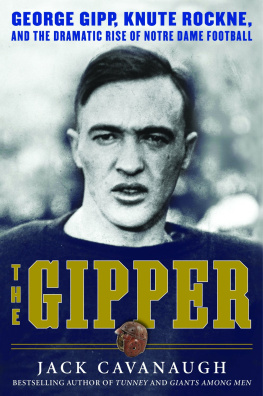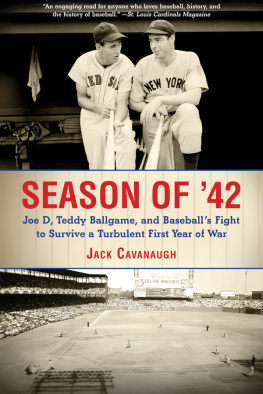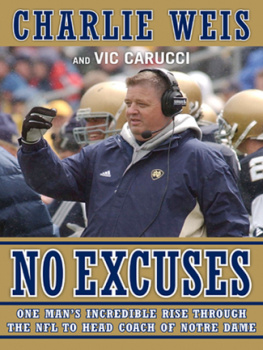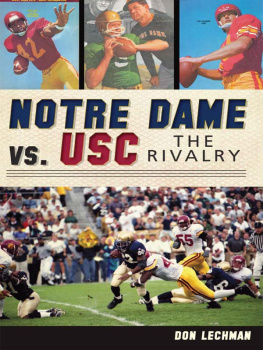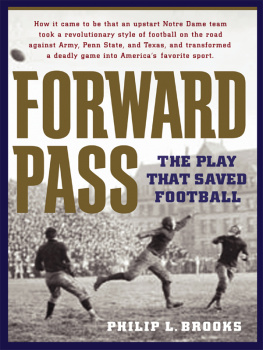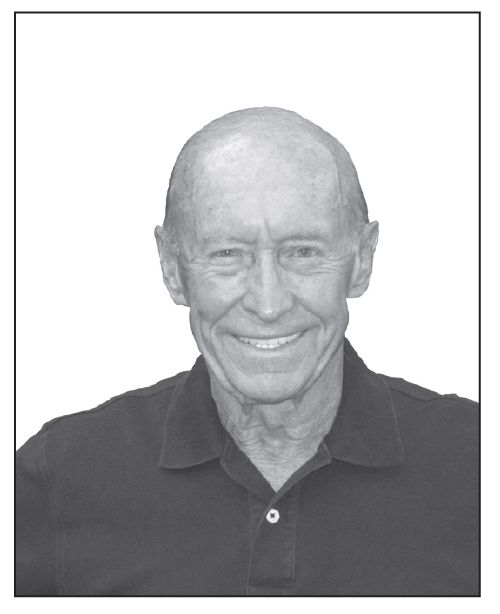ACKNOWLEDGMENTS
FIRST AND FOREMOST, everyone I dealt with at Notre Dame was not only cooperative but in many instances went out of their way to help me in my research without ever asking what I might write about the universitys most mythical, albeit flawed, sports figure, George Gipp. I am especially grateful to Charles Lamb, the head of the Archives department at Notre Dame and to his assistants Wendy Schlereth, Angela Kindig, and Sharon Sumpter for the time they spent with me during my research at Notre Dame and for the materials provided by the Archives department, both during my visit and in the months thereafter.
I am also indebted to John Heisler, the schools senior associate athletic director for media and broadcast relations, and his staff, particularly senior staff assistant Carol Copley, who was of immeasurable help, always quick to respond to a query in her joyful fashion. A tip of the hat also goes to Veronica Primrose in the universitys Registrars office for her help in obtaining academic information about Gipp and Knute Rockne. Certainly no one at Notre Dame ever tried to conceal the fact that Gipp, for all of his athletic brilliance, was hardly an academic standout. For assistance on Gipps exploits as a baseball player at Notre Dame, I found Cappy Gagnon, a historian on Fighting Irish baseball teams, to be a font of information.
Research on this book had a long life. It started with a story I did on Gipp more than 30 years ago for Sports Illustrated. During the course of that research, I interviewed a number of Gipps former teammates, including Heartley Hunk Anderson, Fred Ojay Larson, Roger Kiley, and Chet Grant while all of them were in their eighties. With more notes and good quotes than I could fit into my Sports Illustrated story, I stored them in my files, determined that someday I would write what I hoped would be a definitive biography of Gipp. My timing for my interviews with Anderson, Larson, and Kiley, along with some of Gipps boyhood friends, was propitious, since, sadly, they all died within the next few years. Looking back, it was a joy talking with Anderson, Larson, Kiley, and Grant about Gipp and Rockne and Notre Dame football in the years shortly before, during, and after World War II. As a boy who grew up hoping to play football at Notre Dame while the university band played the countrys best-known fight song, the Notre Dame Victory March, I was familiar with the Gipp legend and with the legendary Rockne, and so to talk to men who played with Gipp and for Rockne was both a labor of love and a pleasant trip down college footballs Memory Lane.
As any writer of nonfiction knows, libraries and librarians are an immense resource and always willing to help. Once again, as in my two previous books, Tunney and Giants Among Men , Susan Madeo at the Westport, Connecticut, Library was invaluable in securing old and obscure books through the interlibrary loan and microfilm of old newspapers including the South Bend Tribune, the Daily Mining Gazette , which is published in Houghton, Michigan, and the long-defunct South Bend News-Times. Yvonne Robillard, an editor of the Daily Mining Gazette, which circulates in Gipps hometown of Laurium, Michigan, and nearby Calumet, where Gipp, Hunk Anderson, and Ojay Larson went to high school, was also a great help.
Information on Gipps irregular high school career and the plaque awarded in his honor at the end of every school year came from George Twardzik, principal of Calumet High, and Elsa Green, an administrative assistant at the school in Michigans Upper Peninsula, close by Lake Superior. Extremely helpful about Gipps pre-Notre Dame days in the Calumet area came from Bob Erkkila, a retired Calumet teacher, while Ed Vertin, the town administrator in Laurium, provided information about the George Gipp Recreation Area complex in his hometown and the memorial that was erected in honor of Lauriums most famous native son. Ron and Karl Gipp, cousins of George Gipp, also provided nuggets of information about the family, particularly George Gipps early days, while Nils Rockne recalled what he had heard about his famous grandfather.
Writer Emil Klosinski, whose father, John, played on a semi-pro team with Gipp while Gipp was at Notre Dame and is also the author of a book about Gipps days in South Bend, was an excellent source of information. So was Emils son, Marc, who went out of his way to try to help me track down Victoria Adams Phair, the granddaughter of Iris Trippeer, the love of Gipps life. Victoria Phair, in turn, was gracious and helpful in reminiscing about her beautiful grandmother, who for reasons still not known left Gipp heartbroken, but still professed her love for him in the years following his untimely death.
Others who contributed to this book included Joseph Mendelson of Santa Barbara, California, a longtime benefactor at Notre Dame, who put up the funds for a Knute Rockne statue outside Notre Dame Stadium; Joe Heintzelman, owner of Oscars Billiards Club, a virtual landmark in South Bend, who recalled how his grandfather, for whom the billiards parlor is named, played billiards with Gipp while Gipp was at Notre Dame; Mike Stack, the public relations manager for the St. Joseph Regional Medical Center in South Bend, the hospital where Gipp died; Dr. Charles Higgs-Coulthard, a staff physician at St. Joseph; Patrick Furlong, professor emeritus of history at Indiana University, South Bend, who furnished information on what South Bend was like during the World War I era along with other historical information about both the city and the state of Indiana at that time; Kent Stephens, historian and curator at the College Football Hall of Fame in South Bend; Mady Salvani of the Athletics Communications Office at West Point for her assistance in producing materials on the long Army-Notre Dame rivalry; and Minnie Bartsch of the Rockne Historical Society in Rockne, Texas, who told me the delightful story of how and why a small Texas town is named after the most famous football coach of all time.
Once again, I must thank my agent, Andrew Blauner, for seeing to it that this book, like my two previous books, found its way into print and for his confidence in the project from the outset. Thanks, too, goes to my editor at Skyhorse Publishing, Mark Weinstein, for his editing skills after having left me to my own devices throughout the reporting and writing process. Last but most definitely not least, a ton of thanks to my computer guru, Paul McLaughlin of Norwalk, Connecticut, who was always quick to respond, by phone or in person, whenever I encountered technical problems and who, with his encyclopedic knowledge of computers, unfailingly resolved them, usually in a matter of minutes, often without having to make a house call.
Also by Jack Cavanaugh:
Damn the Disabilities: Full Speed Ahead!
Tunney: Boxings Brainiest Champ and His Upset of the Great Jack Dempsey
Giants Among Men: How Robustelli, Huff, Gifford, and the Giants Made
New York a Football Town and Changed the NFL
ABOUT THE AUTHOR
JACK CAVANAUGH is a veteran sportswriter whose work has appeared most notably on the sports pages of The New York Times , for which he has covered hundreds of assignments. He is the author of Damn the Disabilities: Full Speed Ahead! (1995), Giants Among Men (2008), and Tunney (2006), which was nominated for a Pulitzer Prize in biography. In addition, Cavanaugh has been a frequent contributor to Sports Illustrated and has written for Readers Digest , the Sporting News, and Tennis and Golf magazines as well as other national publications. He is also a former reporter for ABC News and CBS News. Cavanaugh, a native of Stamford, Connecticut, is currently an adjunct professor at the Columbia University Graduate School of Journalism and lives with his wife, Marge, in Wilton, Connecticut.

